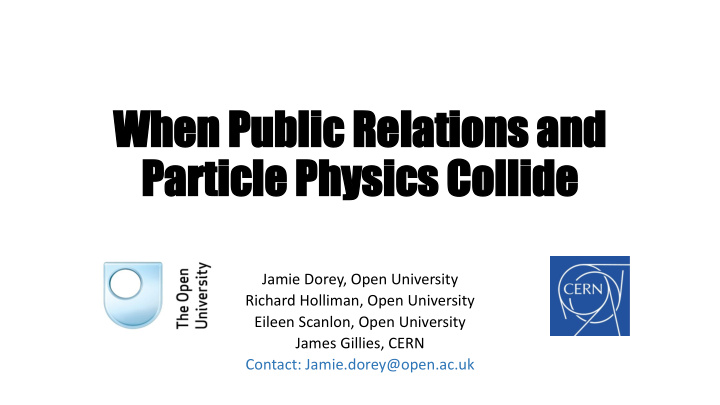



Wh When n Pu Publ blic ic Re Rela lati tions ons an and d Particle Pa ticle Ph Physi ysics cs Co Coll llid ide Jamie Dorey, Open University Richard Holliman, Open University Eileen Scanlon, Open University James Gillies, CERN Contact: Jamie.dorey@open.ac.uk
Overview • Documentary analysis; ethnography; interviews (Dorey, 2015) • The Position of Scientific Public Relations in the Circuit of Mass Communication • f rom ‘Press Office’ to ‘Communications Group’ • Introduction to CERN: ‘Adhocracy’ Organisation • CERN’s ‘Official’ Communication Architecture • Tensions Rising from the Centralisation of Communication Functions • ‘digital scholarship’ and social media
Circuit of Mass Communication • Four Main actors • Interact to influence production, content and reception of media coverage • ‘pre - digital’ model • Where do Press offices sit within this circuit? • Intermediary position Press Offices/ between Scientific Institutes Science Media and the Media Centres (Miller, et al . 1998)8)
CERN Communications Group: additional functions 1 4 2 3 (Adapted from Miller, et al. 1998)
CERN • More than 10,000 scientists from 600 universities in 113 countries. • Four Main Detectors: ATLAS, ALICE, CMS, LHCb • 'Adhocracy' organization: • Complex environment • Unique outputs • Multidisciplinary teams • No single person dictates • Organised competition between experiments • within a culture of openness
CERN’s Communication Architecture • Decentralised Communication Network • Allows more participants • Increase feelings of belonging • Harder to coordinate at a strategic level • Coordinated roles and responsibilities • Reward and recognition
Issues around Centralised Communication • Easier to meet strategic goals • Can limit the number of voices heard; gatekeepers vs. bottlenecks • Need a balance between DIY and Command and Control approaches to Communications • digital scholarship and engagement via social media • Public Relations Groups may lack the resources to support individual communication activities
Points for Discussion What role should Press Offices/Communication Groups play in the public arena? To what extent should the press officer act as a critical journalist? (from Fahy, 2011) Corporate science writing or science journalism, can the public tell the difference - and does it matter who writes the story? Command and Control vs DIY Communication: Could/should public relations groups promote DIY communication strategies amongst researchers?
Recommend
More recommend